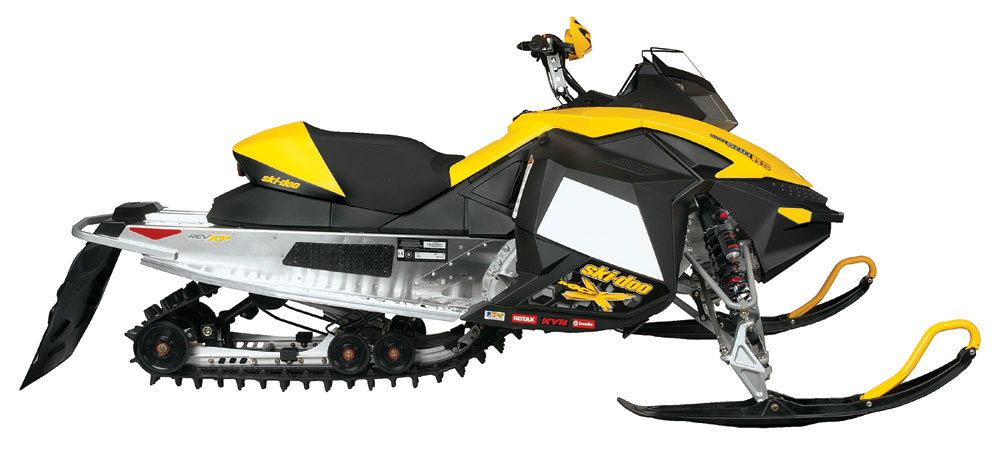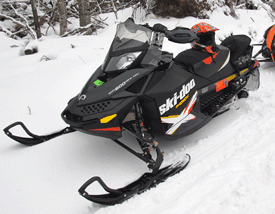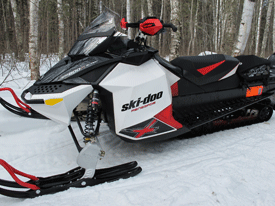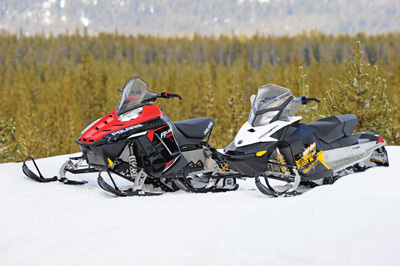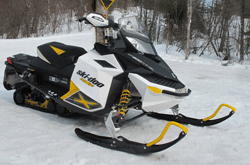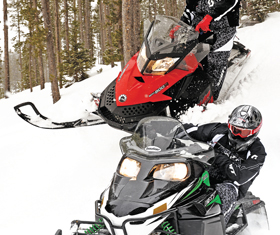2008 Ski-Doo MXZ 800R X
STATS
Sled: 2008 Ski-Doo MX Z 800R X
MSRP: $10,399
Modifications: Fett Brothers Performance. custom shock valving, Ski-Doo XP semi-rigid tunnel bag.
When we took delivery of our 2008 snowmobile fleet late last fall, the Ski-Doo MX Z 800R X was one of the first sleds we rode. It was also the first sled that needed some setup help.
We pulled the rope and hit northern Wisconsin trails in December and quickly realized the setup could be better. While it coasted easily through corners, it handled poorly when on the throttle due to too much weight transfer that made the skis push through turns.

As predicted, we learned that the lightweight REV-XP chassis reacts to subtle spring setting changes more than other machines. It’s one of the reasons a lighter vehicle is tougher to calibrate. The X-package sled was delivered with the preload on both front shocks set full-soft. After testing a few different settings, we finalized our handling with the preload up three clicks. In the skid, we reduced the spring preload eight turns on the front shock and found pure delight with the handling. We played with the rear shock settings and front shock compression settings for different drivers and different conditions with pleasing results until we had our shocks custom-valved by Fett Brothers Performance in Frazee, Minnesota, and then enjoyed the sled even more.
In addition to its razor-like, intuitive handling and capable suspension, one of the reasons we enjoyed life aboard the sled was because of the 800R engine. It was a quick-revving powerhouse that loved to sprint from corner to corner. Though it begged to have the throttle squeezed hard, when we computed mileage over several rides we averaged an impressive 12.73 mpg. This was about 2 mpg better than another manufacturer’s 700-class sled measured in the same periods.
Engine vibration was much better controlled than on prototypes we tested. Prior to final production, BRP installed a starter ring gear on the primary clutch of all the 800R models. The ring gear was a harmonic balancer to tune out some of the vibration.

Ski tips, the minimalist windshield and handguards — with cheap, plastic mounts — still shook at idle. But once moving, the sled seemed cured from its “unreasonable” status we reported on the prototypes; vibrating no more than other big-displacement twins. During our season we put 1,047 miles on the odometer. The only maintenance required was one belt replacement.
Ergos on the new XP were excellent. We loved the ease of moving from side-to-side on the sled and liked the various positions the cockpit afforded to ease riding for anyone on the comfy (though sticky) seat.
Fit and finish is a step backward from the REV chassis it replaced. Small, lightweight plastic covers that disguise the seat mounts went missing early in the season. Where side panels notch into place was another source of missing plastic, but all the panels fit snugly thanks to the rubber latches.

The power-to-weight ratio was untouchable by another stock sled. It accelerated fiercely and could lift the skis off snow-covered laketops at 70 mph with a little tug on the handlebars. The whole package added a second layer of thrill-ride fun because the MX Z 800R X was the lightest, easiest-to-throw-around sled we’ve ever had in our fleet.

